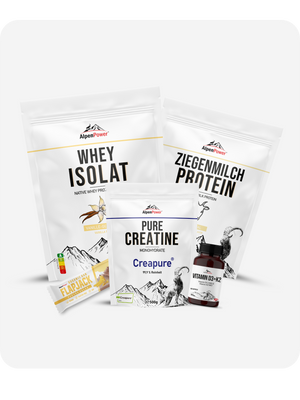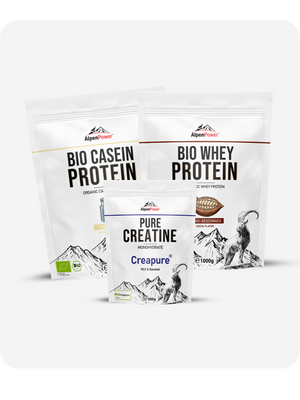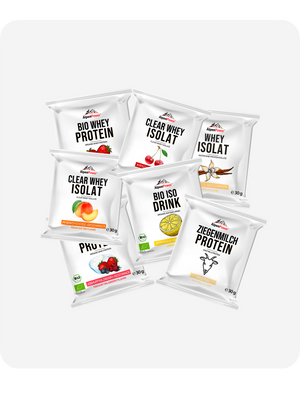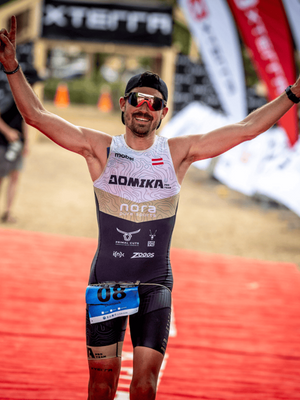Long endurance units - whether marathon preparation, cycling marathons or triathlon training - expose the body to high physiological stress. In addition to muscular fatigue, the increased energy expenditure also causes changes in the hormone balance, the immune system and the cell structure. Targeted regeneration, which includes both active recovery training and an adapted diet, is crucial in order to optimally process the training stimulus and avoid overloading.

Regeneration begins immediately after exercise
The first few hours after a long endurance session are what is known as a metabolic "open window " - a phase in which the metabolism and muscles are particularly receptive to nutrients. It is during this window that glycogen stores are replenished most quickly, muscle damage is repaired and inflammatory processes are regulated.
Micronutrients: small building blocks, big effect
After intensive long-term endurance, the need for antioxidants, electrolytes and certain vitamins and minerals is increased.
- Magnesium & potassium: support muscle relaxation and nerve function.
- Vitamin C & E: help to reduce oxidative stress.
- B vitamins: important for energy metabolism.
- Zinc: supports the immune function.

These micronutrients can be supplied through a varied, wholesome diet - or specifically supplemented with recovery products if the need is particularly high.
Protein: the foundation of regeneration
Endurance training causes microtraumas in the muscles that require repair. 1.6-2.2 g of protein per kilogram of body weight per day also makes sense for endurance athletes. Immediately after training, a portion of quickly digestible protein (20-40 g) is recommended to immediately stimulate muscle protein synthesis. An AlpenPower recovery shake based on organic whey protein provides high-quality amino acids and can be combined with carbohydrates (e.g. from banana, oats or organic maltodextrin DE10) if required to replenish glycogen stores at the same time.
Omega-3 fatty acids: inflammation modulators
Long-term endurance training can promote inflammatory processes in the body. Omega-3 fatty acids (EPA and DHA) from fish oil or algae oil have an inflammation-modulating effect and support cell membrane integrity. AlpenPower Omega-3 capsules offer a simple, highly concentrated supplement to ensure daily intake.
Active regeneration - more than just a break
Regeneration training involves light, easy exercise that promotes blood circulation, removes metabolic waste products more quickly and maintains mobility. Examples include 20-40 minutes of easy cycling, swimming or walking. Mobility exercises and gentle stretching also support the recovery process.

Example daily plan for a recovery day
Morning: High-protein breakfast (e.g. oatmeal with whey isolate and berries) + omega-3 capsules. Morning: 20-30 minutes of light cycling or yoga. Lunch: Whole meal with lean protein (e.g. chicken or lentils), vegetables and healthy fats. Afternoon: Fruit and nut snack; drink plenty of fluids and electrolytes. Evening: Light meal, e.g. omelette with vegetables and wholemeal bread. Optionally a small portion of AlpenPower regeneration shake if you have not yet reached your protein intake.
Conclusion
Optimal recovery after long endurance sessions is a combination of targeted nutrient timing, micronutrient supply, protein intake and moderate active training. Those who consistently implement these building blocks and integrate high-quality products such as AlpenPower regeneration shakes and omega-3 capsules can not only regenerate faster, but also increase their performance in the long term and prevent injuries.
Author: Laura Bahmann
Sources:
- Peake, J. M., Neubauer, O., Della Gatta, P. A., & Nosaka, K. (2017). Muscle damage and inflammation during recovery from exercise. Journal of Applied Physiology, 122(3), 559-570. https://doi.org/10.1152/japplphysiol.00971.2016
- Beelen, M., et al. (2010). Nutritional strategies to promote postexercise recovery. International Journal of Sport Nutrition and Exercise Metabolism, 20(6), 515-532. https://doi.org/10.1123/ijsnem.20.6.515
- Philp, A., Hargreaves, M., & Baar, K. (2012). More than a store: Regulatory roles for glycogen in skeletal muscle adaptation to exercise. American Journal of Physiology-Endocrinology and Metabolism, 302(11), E1343-E1351. https://doi.org/10.1152/ajpendo.00071.2012
- Morton, R. W., et al. (2018). A systematic review, meta-analysis and meta-regression of the effect of protein supplementation on resistance training-induced gains in muscle mass and strength in healthy adults. British Journal of Sports Medicine, 52(6), 376-384. https://doi.org/10.1136/bjsports-017-097608
- Philpott, J. D., Witard, O. C., & Galloway, S. D. R. (2018). Applications of omega-3 polyunsaturated fatty acid supplementation for sport performance. Research in Sports Medicine, 27(2), 219-237. https://doi.org/10.1080/15438627.2018.1552325











